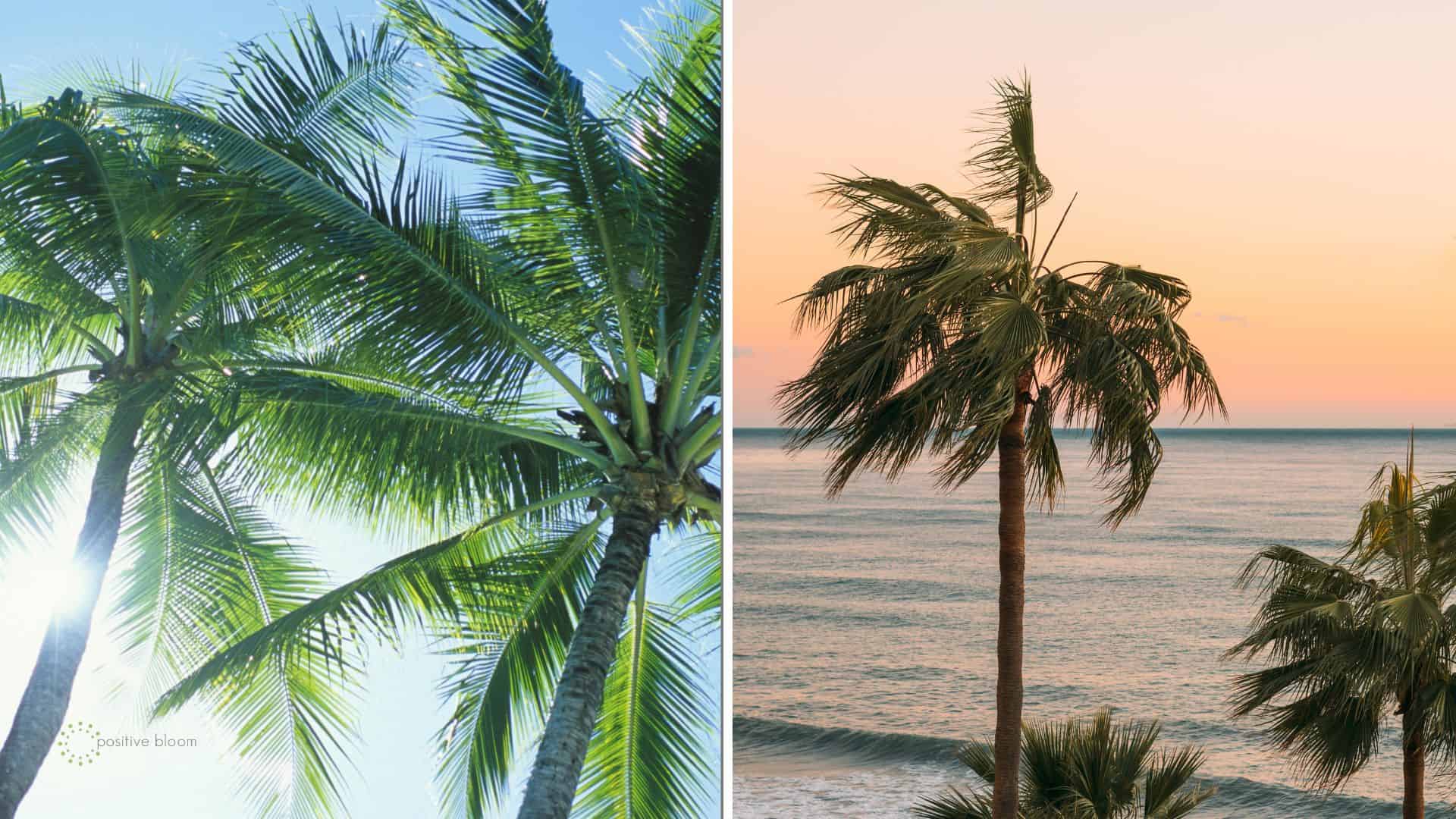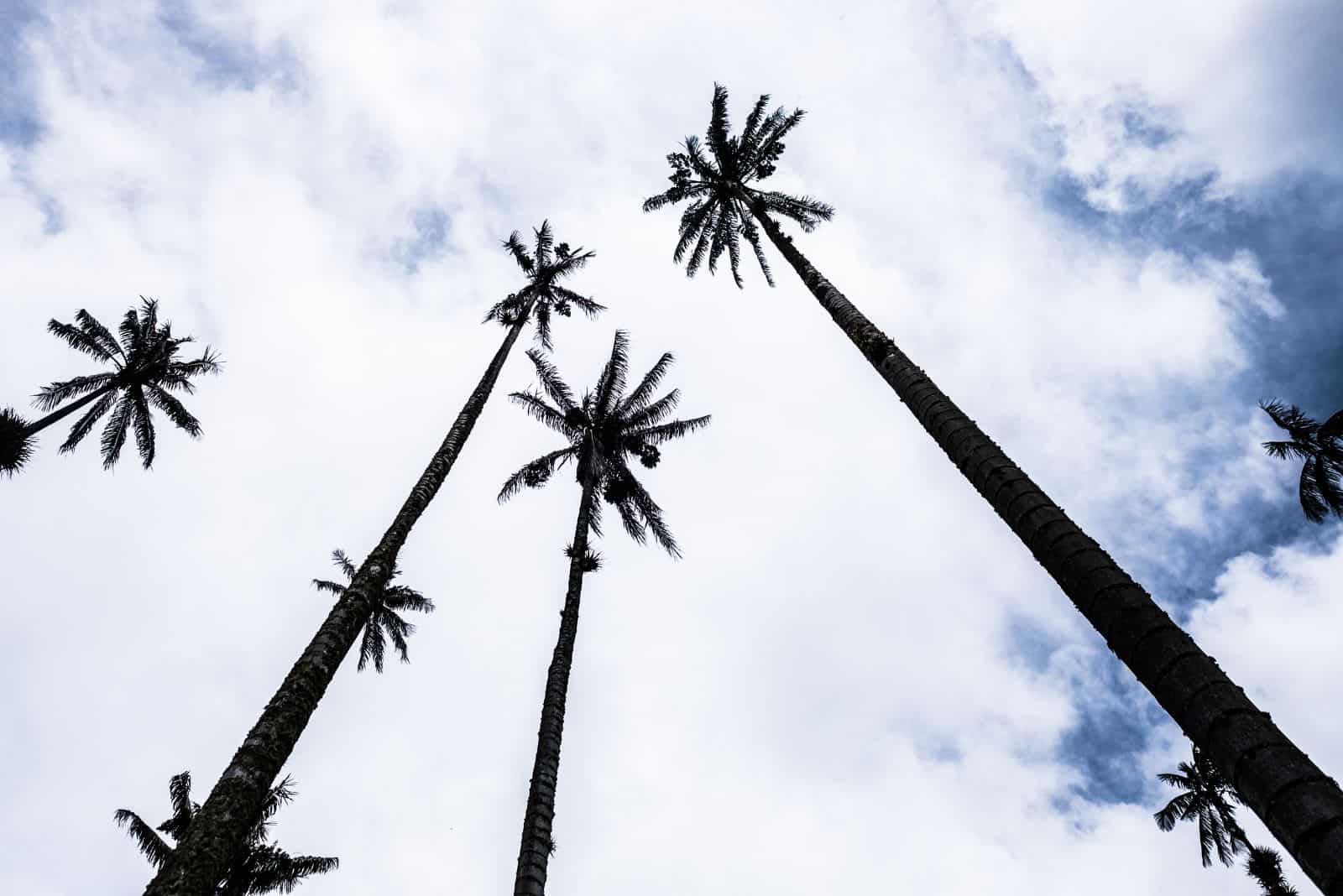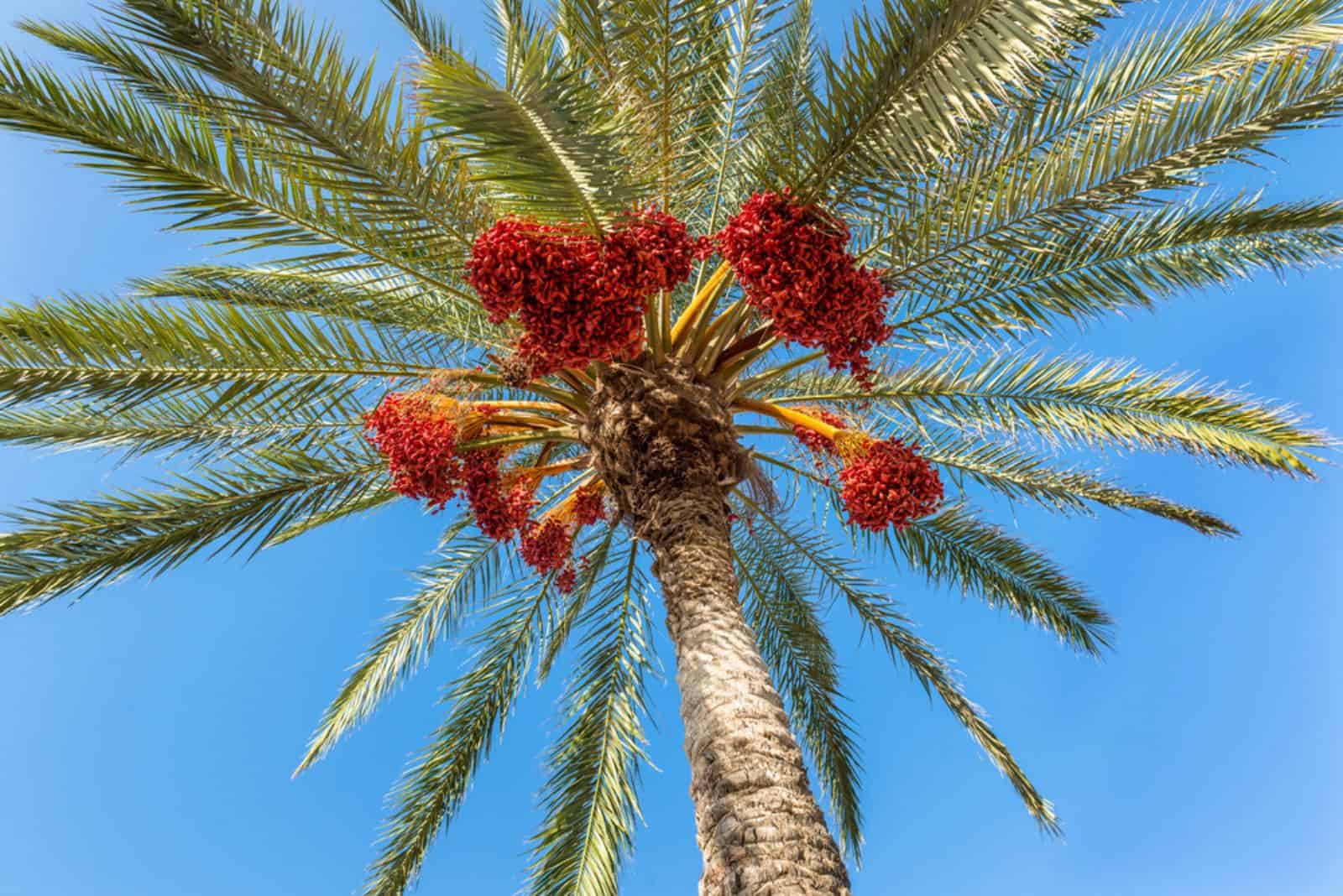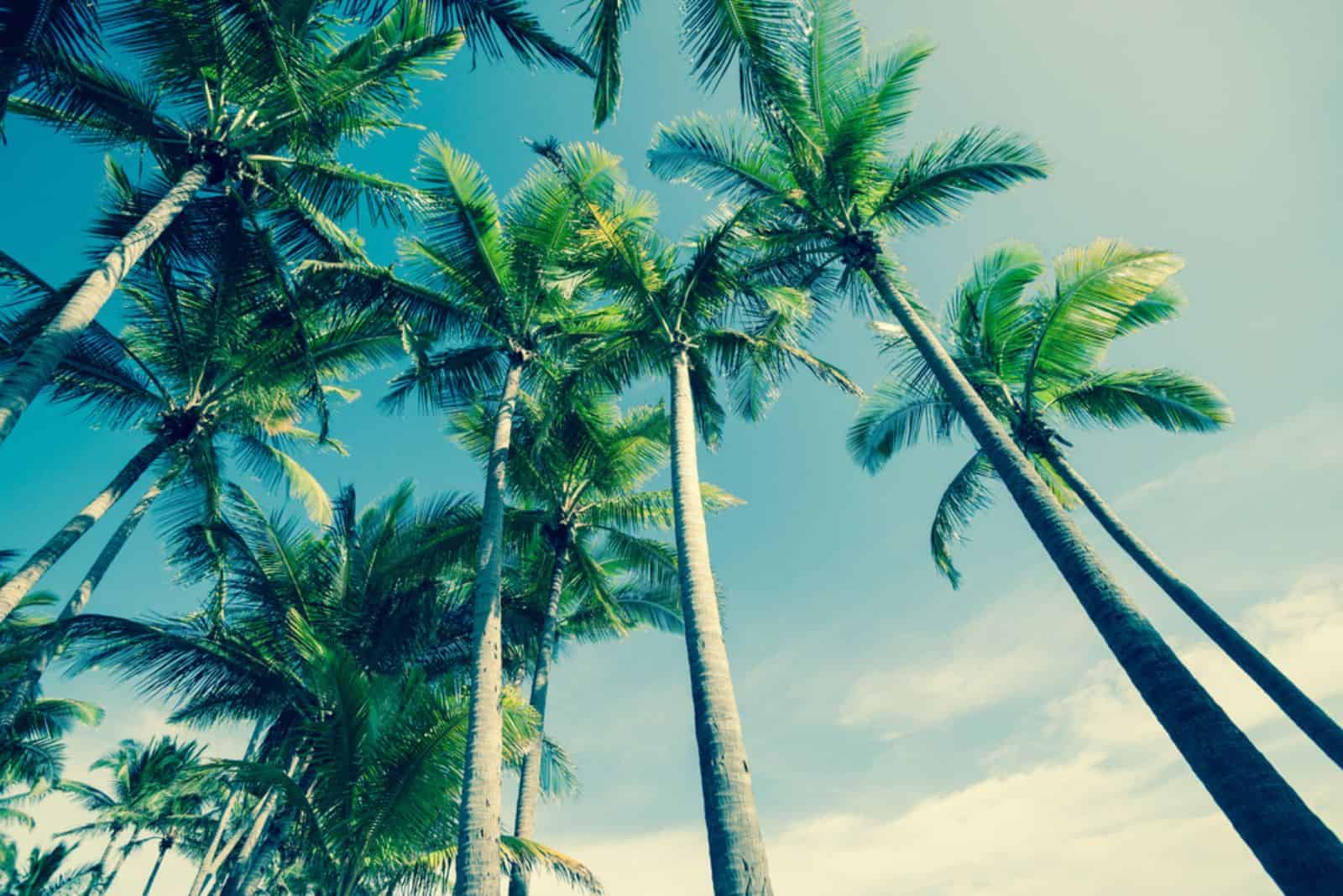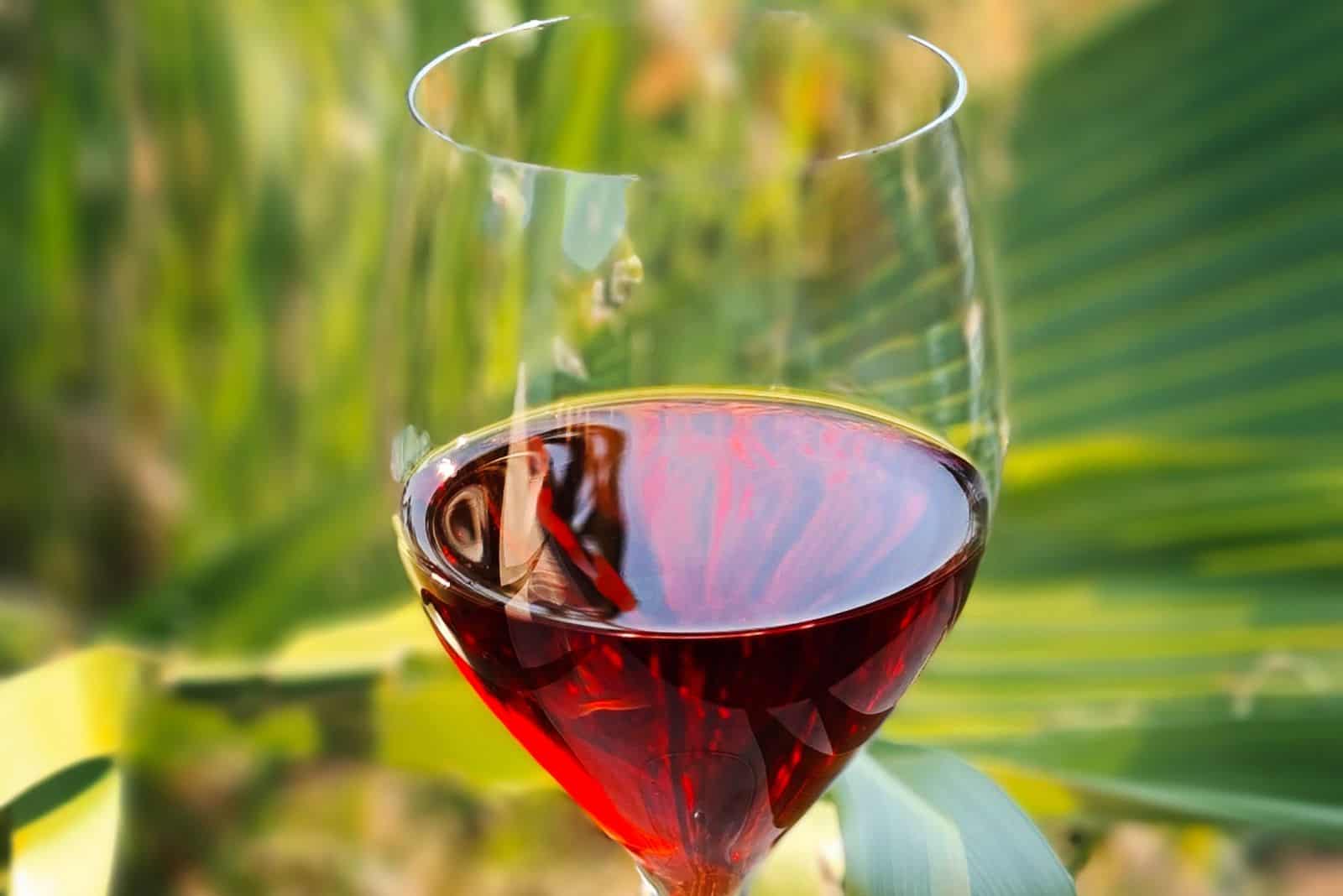Taking that big step and getting a palm tree for your home or front yard might be a bit overwhelming. I mean, there are some giants out there!
However, there’s something for everyone – even dwarf varieties for indoors.
These trees can give your home a feeling of the tropics and make it seem like summer all year round.
And if that’s not enough, check out these mind-blowing palm tree facts that can give you some inspiration to get one.
A few really surprised me!
P.S. They most likely inspired some of these wonderful palm tree quotes.
Let’s get started!
1. The Tallest Living Palm Tree
According to the Guinness Book of World Records, the tallest palm tree that lives to this day is the Quindío wax palm in Colombia.
These trees reach head-spinning heights of as much as194 feet.
However, there are historical records claiming that these species were even taller in the past, with individual trees reaching up to 200 ft. (1)
Other palm tree varieties that come close to these heights are the Caribbean royal palm (187 ft) and black wanga palm, which both reach 164 ft.
2. Most Palms Planted Within 10 Years
Believe it or not, there is a Guinness World Record for the country that planted the most palm trees within a 10-year period.
The United Arab Emirates planted 42 million palms from 1999 to 2009. (2)
Makes your head spin!
3. Oldest Palm Trees
One of the oldest palm trees today is nicknamed the “Methuselah” because it sprouted from a 2000-year old seed in 2005.
An expert in desert agriculture, Solowey, managed to germinate that seed. The tree grew and still stands in the Arava Institute research park. (3)
4. First Cultivated Date Palm Was In Mesopotamia
There are many palm tree varieties out there, and date palms are one of the best.
They’re very old, and we know for a fact that they were cultivated during the Mesopotamian era in 5,000 BC. (4)
From there, the date palm spread all over the Middle East, mainly in southeastern Iran and eastern Arabia.
5. The Heaviest Seed In The World
Another record-breaking palm tree is the coco de mer, also known as “Lodoicea”. This species produces the heaviest seed in the world.
It weighs around 55 pounds, while the fruit that it holds is around 100 pounds. (5)
But that isn’t the only interesting information about this tree; it can live to 350 years old and needs about a century to reach its full size.
6. Endangered Palm Trees
As strange as it may seem, there are many palm trees in danger of extinction. As reported by the IUCN red list, the Tahina palm is critically endangered.
There are over a thousand palm species threatened with extinction, and regions such as Vietnam, New Guinea, and Vanuatu hold their conservation in high priority. (6)
The same research warns of how many of these trees are irreplaceable. Their disappearance can harm ecosystems because they provide shelter and food for animals and humans.
7. There Are Around 2,600 Species
According to Baker and Dransfield, there are approximately 2,600 species of palm tree classified in 181 genera.
The categorization changes frequently, and while some species have fallen into synonymy (gained new names), eight new genera and 200 novel species have been described. (7)
Therefore, it’s not surprising that many of these varieties have similar appearances. For instance, there are only subtle differences between the parlor and areca palm, such as their size, leaf color, and texture.
However, they look pretty much the same to the untrained eye, just like many other species. But it’s important to distinguish between them since they may have different requirements, and no one wants to accidentally kill their new plant!
8. Symbolism Throughout History And Cultures
Palm trees have a rich history in many different cultures and are often referred to as spiritual trees. You’ll find references to them in the Bible, old Assyria, Ancient Rome, etc.
Ancient Rome – In Ancient Rome, the palm branch symbolized triumph and victory. It was awarded to war heroes and champions. Even the Latin word palma means “victory.” (8)
Assyria – The palm tree was a sacred tree in Assyria, which connected heaven and earth with its fronds and the trunk. It was associated with the goddess of fertility and love, Ishtar. (9)
Christianity – In the Bible, Jesus’ followers welcomed him in Jerusalem by laying palm fronds as he rode on a donkey. The palm is, therefore, still a symbol of triumph (just like it was in Ancient Rome), but it got its own day – Palm Sunday.
Islam – In many middle-eastern cultures, the palm is a sign of rest and hospitality. Additionally, its presence around oases symbolizes water as a gift of God. (10)
Mesopotamia – In Mesopotamia, palm trees, and date palms in particular, signified fertility.
9. Palm Trees Are Not Real Trees
We always refer to them as trees, but palms are not actually trees. This mistake has to do with their height and appearance.
But why aren’t they true trees?
It’s because all trees have something palms lack – a secondary growth. Actually, some palm trees do have this type of growth, but don’t have the cambium soil characteristic of trees.
I don’t want to bother you with the details, so I’ll just say that when you cut down a palm tree, you don’t see any tree rings. And that’s because they don’t produce cambium. (11)
10. Some Are Not Even Real Palms
Words sometimes seem to just confuse us. Palm trees aren’t real trees, and some palms aren’t even palms.
When you discover indoor palm tree species, you’ll notice that some of the most popular ones aren’t true palms.
Instead, they only look like they belong to this family, which is why we refer to them as palms. Some examples of such plants are sago and coontie palms, which are actually cycads, and succulents such as the Madagascar and ponytail palm, etc.
11. Most Of Them Have Edible Fruit
We all know about coconuts and date palms, which have edible fruit, but they’re not the only ones.
Acai palm tree – This species produces the famous acai berries.
African oil palm – Many species produce fruit used to make palm oil, and the most common source of this ingredient is African oil palm.
Areca palm – This variety produces a betel nut, which many people eat, especially in southeastern Asia. This fruit has carcinogenic effects, causes various heart diseases, diabetes, affects hormones, immune system, and more. (12)
Chilean wine palm – People usually consume the seed of this palm tree instead of the fruit since it’s tasteless and dry. The seed, on the other hand, has a coconut flavor, and who wouldn’t want to eat that? Finally, it’s popular to make wine from the tree’s sap, although collecting it kills the plant.
Coconut palm – The most famous palm tree is the coconut palm. Its fruit is so healthy that you can use fresh coconut water as IV fluid, and it’s the only plant in nature that you can safely use that way. (13)
Jelly palm – The bitter-sweet fruit of this tree is said to have a slight note of pineapple flavor. Eat it fresh, use it to make jellies (of course), or ferment it into wine.
Peach Palm – The juicy fruit of this variety comes with a tinge of peachy flavor.
Of course, these aren’t the only palm trees with edible fruits, but they are the most famous ones. We can’t describe them all because it’d take ages!
12. Palm Tree Wine
I know it sounds strange, but people actually make wine out of palm trees. Chilean wine and palmyra palms are the most famous ones, but date and coconut palms can also be used to produce this intoxicating beverage.
People collect the sap by felling the entire tree or cutting flowers. They then ferment it into a weak alcoholic liquid with a sweet flavor – and it only takes about 2 hours to do so.
13. They Have Three Types Of Leaves
There are three types of palm fronds: pinnate, palmate, and costapalmate. (14)
The pinnate leaves look like feathers and the leaflets are completely divided. They’re connected to the rachis (an extended petiole). Coconut and date palms have these leaves.
The palmate leaves resemble fans and adjoining leaflets are connected with a part or most of their length. Unlike with the pinnate fronds, the leaflets of this foliage grow from a single point on the petiole. Mexican and windmill palms have these fronds.
The costapalmate leaves are a combination of pinnate and palmate ones. The leaflets are connected with a part or most of their length, but are attached to the costa – an extended petiole. Chinese fan and bismarck palm trees have this foliage.
No matter what species you have, yellow palm tree leaves are a common issue for them all. Therefore, make sure to give your plant enough light, but not too much, never overwater them, and feed them regularly with some palm tree fertilizer.
14. You Should Wash Your Palms But Not Prune Them
Though it may seem strange, washing your palm trees from time to time has many benefits. You’ll remove dust from their glossy fronds, knock off any bugs, and even increase humidity.
Of course, if you go overboard with this, it may lead to your palm tree dying, especially if you irrigate them too frequently. So remember to do everything in moderation!
Additionally, you shouldn’t prune large palm trees all by yourself. The cut fronds can slide down onto you, pin you to the trunk, and suffocate you.
Always call your local arborist if you want your palm tree trimmed.
15. Some You Can Prune Into Bonsai
Many gardeners have wondered how to take their enormous palm trees indoors. And while science still hasn’t figured this out, I have an ingenious solution – turn into a bonsai!
Of course, most palm trees cannot be grown using this technique. They don’t have any branches you can prune and their root systems don’t handle the trimming well.
However, ponytail and sago palm bonsai aren’t unheard of. The sago palm is more popular since it grows almost anywhere. However, the ponytail is also low-maintenance and both of these species take well to pruning.
Final Thoughts
This article included 15 incredible palm tree facts! There are around 2,600 species, some cultivated in 5,000 BC and some around 2,000 years old. And over a thousand of them are endangered!
They are tall, have different symbolism in different cultures, you can eat their fruit, and some have such heavy seeds that it’s a workout just to pick them up!
Until next time!
References:
1. Guinness World Records (2017). Tallest Living Palm Tree.
2. Guinness World Records (2009). Most Palm Trees Planted in 10 Years.
3. Roach, J. (2015). ‘Methuselah’ Palm Grown From 2,000-Year-Old Seed Is a Father. National Geographic.
4. Tengberg, M. (2012). Beginnings and Early History of Date Palm Garden Cultivation in the Middle East. Journal of Arid Environments.
5. Blackmore, S. et. al. (2012). Observations on the Morphology, Pollination and Cultivation of Coco de Mer (Lodoicea maldivica (J F Gmel.) Pers., Palmae). Journal of Botany.
6. Bellot, S. et. al. (2022). The Likely Extinction of Hundreds of Palm Species Threatens Their Contributions to People and Ecosystems. Nature Ecology and Evolution.
7. Baker, W. J. & Dransfield, J. (2016). Beyond Genera Palmarum: Progress and Prospects in Palm Systematics. Botanical Journal of the Linnean Society.
8. Vioque, G. G. (2002). Martial, Book VII: A Commentary. Translated by J.J. Zoltowski.
9. Marina, G. (2007). The Assyrian Sacred Tree: A History of Interpretations. Academic Press / Vandenhoeck Ruprecht.
10. Chase, Holly (1990). The Date Palm: Pillar of Society. Oxford Symposium on Food and Cookery 1989: Staples. Prospect Books.
11. Smit, K. T. (2013). Do You Believe in Palm Trees?. Landscape Hawaii.
12. Garg, A., Chaturvedi, P., & Gupta, P. K. (2014). A Review of the Systemic Adverse Effects of Areca Nut or Betel Nut. Indian Journal of Medical and Paediatric Oncology.
13. Campbell-Falck, D., Thomas, T., Falck, T. M., Tutuo, N., & Clem, K. (2000). The Intravenous Use of Coconut Water. The American Journal of Emergency Medicine.
14. Palm Leaf Structure. University of Florida, IFAS Gardening Solution.

